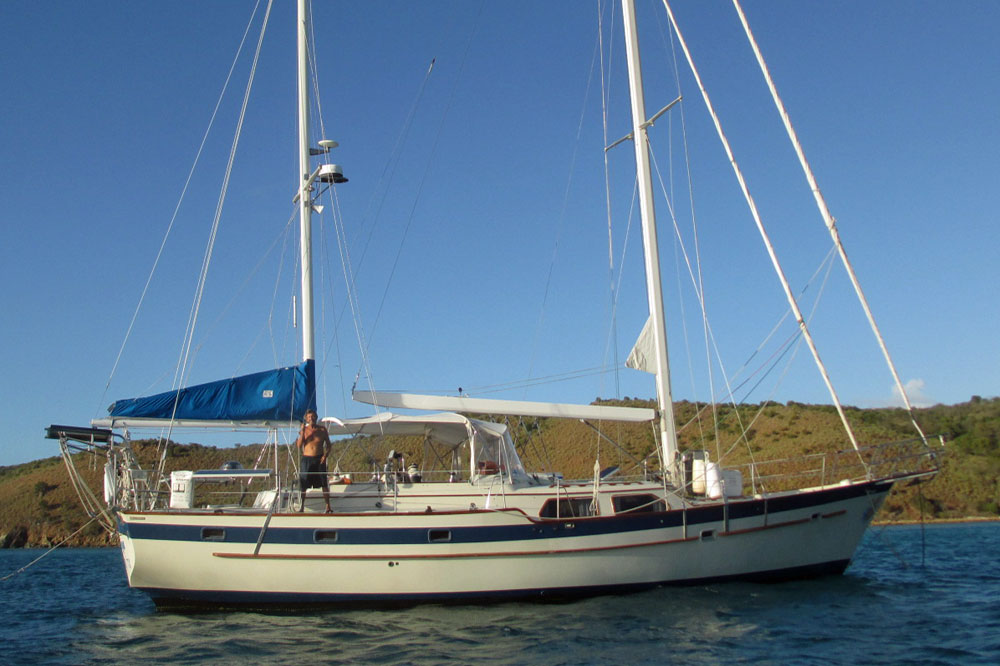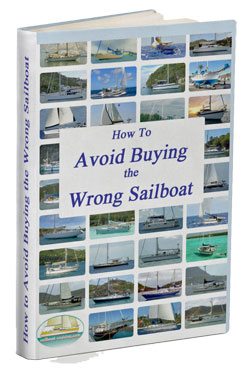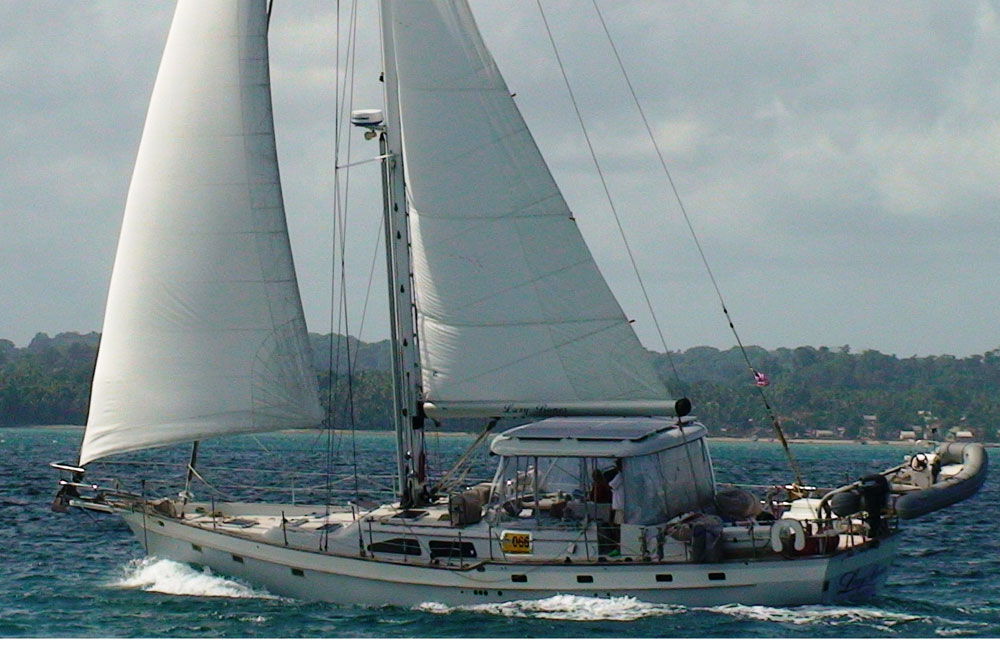- Home
- Sailboats 50'-55'
- Irwin 52
The Irwin 52 Sailboat
Specs & Key Performance Indicators
The Irwin 52, a centre-cockpit staysail ketch, was designed by Ted Irwin and built in the USA by Irwin Yachts.
Published Specification for the Irwin 52
Underwater Profile: Fin keel & skeg-hung rudder
Hull Material: GRP (Fibreglass)
Length Overall: 52'0" (15.9m)
Waterline Length: 44'0" (13.4m)
Beam: 15'4" (4.7m)
Draft: 7'0" (2.1m)
Rig Type: Staysail Ketch
Displacement: 55,000lb (24,948kg)
Designer: Ted Irwin
Builder: Irwin Yachts (USA)
Year First Built: 1976
Year Last Built: 1985
Number Built: 250
Published Design Ratios for the Irwin 52
1. Sail Area/Displacement Ratio: 15.2
2. Ballast/Displacement Ratio: 29.3
3. Displacement/Length Ratio: 288
4. Comfort Ratio: 48.3
5. Capsize Screening Formula: 1.6
Summary Analysis of the Design Ratios for the Irwin 52
1. A Sail Area/Displacement Ratio of 15.2 suggests that the Irwin 52 will need a stiff breeze to get her going. In light conditions, unless you've got plenty of time on your hands, motor-sailing may be the way to go.
2. A Ballast/Displacement Ratio of 29.3 means that a sailboat like the Irwin 52 (which doesn't have a stiffness-enhancing bulb keel), is likely to benefit from being reefed early to keep her sailing upright in a moderate breeze.
3. A Displacement/Length Ratio of 288, tells us the Irwin 52 is clearly a heavy displacement cruising boat. You can load her down with all your cruising gear and equipment and it will hardly affect her waterline. Not an ideal choice for coastal sailing, but she'll come into her own on an offshore passage in testing conditions.
4. Ted Brewer's Comfort Ratio of 48.3 suggests that crew comfort of an Irwin 52 in a seaway is similar to what you would associate with the motion of a heavy bluewater cruising boat. Pitching and rolling will be well damped - your cup of coffee on the salon table stands a reasonable chance of staying there in most conditions.
5. The Capsize Screening Formula (CSF) of 1.6 tells us that an Irwin 52 would be a safer choice of sailboat for an ocean passage than one with a CSF of more than 2.0.
Any Questions?
What other versions of the Irwin 52 were built?
What other versions of the Irwin 52 were built?
There were two versions of the Irwin 52: the standard version and the center cockpit version. The center cockpit version had a larger aft cabin and a smaller cockpit, while the standard version had a smaller aft cabin and a larger cockpit. The center cockpit version was also available with a cutter rig instead of a ketch rig.
What is the accommodation like in the Irwin 52?
What is the accommodation like in the Irwin 52?
The Irwin 52 has a spacious and comfortable interior, with four cabins and three heads. The forward cabin has a V-berth and a private head, the port cabin has two single berths, the starboard cabin has a double berth and a shared head, and the aft cabin has a queen berth and a private head. The saloon has a U-shaped dinette to port and a settee to starboard. The galley is located aft of the saloon, with a three-burner stove, an oven, a refrigerator, a freezer, and ample storage. The navigation station is opposite the galley, with a large chart table and an instrument panel.
What, if any, alternative accommodation layout versions are available for the Irwin 52?
What, if any, alternative accommodation layout versions are available for the Irwin 52?
There were some variations in the accommodation layout of the Irwin 52, depending on the owner's preferences. Some examples are: having a single head in the forward cabin instead of two; having a single large head in the aft cabin instead of two; having an office or a workshop in one of the midship cabins; having a washer/dryer or a generator in one of the lockers; having an extra fuel tank or a watermaker in the bilge.
What sail plan and rigging options are available for the Irwin 52?
What sail plan and rigging options are available for the Irwin 52?
The Irwin 52 was originally designed as a ketch, with a mainmast and a mizzenmast. The mainmast had two spreaders and carried a mainsail, a genoa, and a staysail. The mizzenmast had one spreader and carried a mizzen sail and an optional mizzen staysail. The sail area was about 1,400 square feet. Some owners opted for a cutter rig instead of a ketch rig, with a single mast and three headsails. The cutter rig had more sail area and better performance upwind, but less stability and maneuverability downwind.
What keel options are available for the Irwin 52?
What keel options are available for the Irwin 52?
The Irwin 52 had two keel options: a shoal draft keel and a deep draft keel. The shoal draft keel had a draft of 5.5 feet and a ballast of 16,000 pounds. The deep draft keel had a draft of 7 feet and a ballast of 14,000 pounds. The shoal draft keel offered better access to shallow waters, while the deep draft keel offered better performance and stability.
What is the Irwin 52 like to sail?
What is the Irwin 52 like to sail?
The Irwin 52 is a fast and comfortable cruiser that can handle most sea conditions. It has good speed and power under sail, reaching up to 10 knots in moderate winds. It has good balance and stability, with an easy motion in waves. It has good manoeuvrability and responsiveness, with hydraulic steering and electric winches. It has good visibility from the cockpit and the saloon, with large windows and hatches. It has good ventilation and insulation, with dorade vents and air conditioning.
What is the average cost of a secondhand Irwin 52?
What is the average cost of a secondhand Irwin 52?
The average cost of a secondhand Irwin 52 depends on the year, condition, equipment, and location of the boat. According to YachtWorld.com, as of July 2023, there are seven Irwin 52 boats for sale in the US, ranging from $84,000 to $230,000. The average asking price is $162,873.
Is this boatbuilder still in business?
Is this boatbuilder still in business?
No, unfortunately this boatbuilder is not still in business. Irwin Yachts was founded by Ted Irwin in 1966 and produced over 6,000 boats until 1991, when it went bankrupt due to financial difficulties. Ted Irwin died in 2015 at the age of 74.
What other sailboats have been created by this designer?
What other sailboats have been created by this designer?
Ted Irwin was a prolific and innovative designer who created many sailboats of different sizes and styles. Some of his most famous designs are: the Irwin 10/4, a 34-foot racer/cruiser that won the SORC in 1975; the Irwin 37, a popular center cockpit cruiser that sold over 600 units; the Irwin 43, a spacious and luxurious aft cockpit cruiser that won the Cruising World Boat of the Year in 1986; the Irwin 65, a large and elegant ketch that was one of the first production boats to have a pilothouse; and the Irwin 68, a custom-built flagship that featured a retractable keel and a hydraulic lifting platform.
The above answers were drafted by sailboat-cruising.com using GPT-4 (OpenAI’s large-scale language-generation model) as a research assistant to develop source material; to the best of our knowledge, we believe them to be accurate.
Other sailboats in the Irwin range include:
Recent Articles
-
Is An SSB Marine Radio Installation Worth Having on Your Sailboat?
Apr 14, 25 02:31 PM
SSB marine radio is expensive to buy and install, but remains the bluewater sailors' favourite means of long-range communication, and here's why -
Correct VHF Radio Procedure: Your Questions Answered
Apr 14, 25 08:37 AM
Got a question about correct VHF radio procedure? Odds are you'll find your answer here... -
VHF Marine Radio; Which One is Right for Your Boat?
Apr 14, 25 05:09 AM
If you're looking to buy a VHF Marine Radio the choice can be a bit overwhelming. So what should it be, a fixed VHF or a handheld VHF? Maybe one with AIS or GPS built in perhaps?















